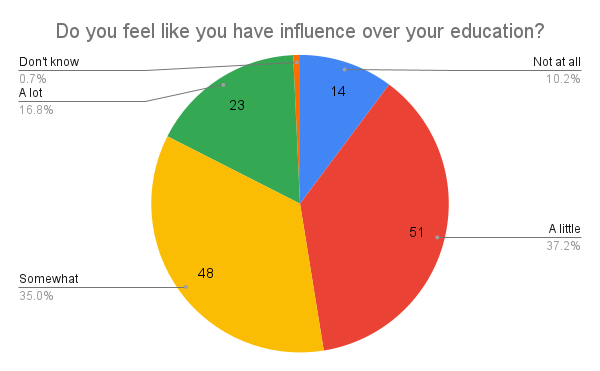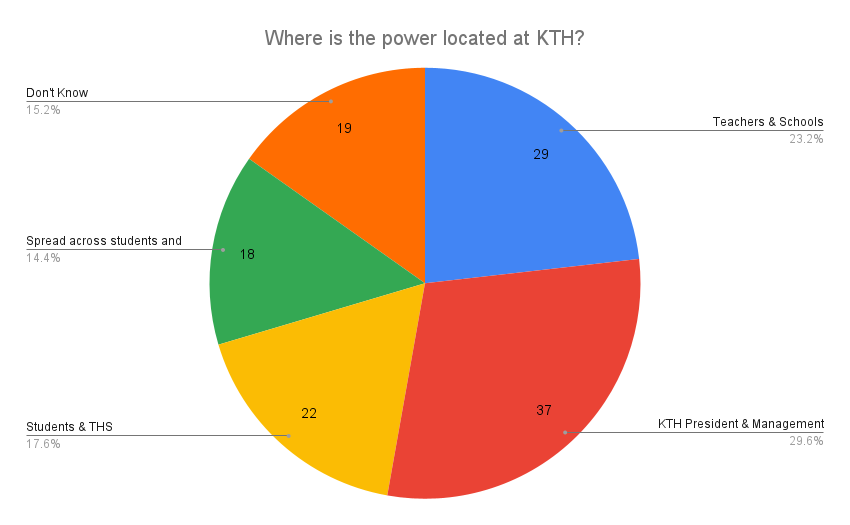Your Influence as a Student
Adam Särnell - Authorsarnell@kth.se

Vendela Hamberg - Illustratorosqledaren@ths.kth.se
What do you do when a teacher ignores your emails? Where is the power located at KTH? And how much influence do KTH students feel that they have over their education? Osqledaren went out to ask these questions and you answered them.
The power dynamics at a large university can be difficult to comprehend since there are so many institutions, roles, associations and other things to keep track of. There is a web of information flows and decision processes that may seem very distant to the ordinary student. In order to get a sense of an average KTH student’s view on this topic we decided to conduct a survey. But before diving into the results, let’s have a brief walkthrough of the organizational structures of KTH and THS and how they are related.
KTH is a public university consisting of five schools that answers to the president of KTH (sv; rektor) – currently Sigbritt Karlsson – and the university board that both are, to simplify, partially appointed by the Swedish government. Each school has a number of departments (sv; instutitioner) that are divided into different divisions (sv; avdelningar) but most importantly: each school offers a selection of programmes to students. Each program has a program director (sv; programansvarig) – subordinate to the head of school (sv; skolchef). They are responsible for the teachers and the courses offered in the program. When it comes to quality assurance of education and research there exists a faculty council (sv; fakultetsråd) consisting of 13 members. A majority of them are KTH professors elected by their fellow teachers and researchers, and three of the members are student representatives from THS.

THS is the student union at KTH. By law, Swedish student unions need to be democratic and the university is required to take their opinion into account when making decisions. In practice, all members of THS are able to vote on which people they want to represent them at different roles in the organization and in their respective chapters (sv; sektioner). The different chapters then have representatives in the union council that decides how the union will operate. Quality assurance, and communication related to it, occur at different levels between THS and KTH. For example, the idea is that course responsible students are appointed to communicate with the course responsible teacher, while each chapter’s study council communicates at one step above – directly to the programme responsibles.
So what does the ordinary student make of all this?
The survey was answered by 138 students, either online or when approached on campus, where 63% responded that they are or have been involved in either their chapter, THS, or both, and 11% of the respondents were international students. The two open-ended questions were deliberately posed in a way that would require the students to think for a bit instead of giving them alternatives to choose from, and the free-form responses were then coded and grouped into larger categories. A consequence of open-ended questions is that respondents are able to fit multiple answers into their response, which means some of the categories have overlaps that will be pointed out where it's needed.


When it comes to student influence, 47,4% of respondents answered that they feel like they have little or no influence over their education. Meanwhile, 35% experience a moderate amount of influence and 16,6% feel like they have much influence. When asked how much they actually utilize this perceived influence, the “moderate” and “much” alternatives dropped by roughly 3 percentage points each, while the amount that responded “little” went from 37,2% to 25,5% and the “none at all” alternative grew from 10,2% to 25,5%.

What would you do if a course responsible doesn’t respond to your emails?
28,9% would contact the programme director (28,9%). Amongst these 39 responses, 14stated they would also consider contacting either the study council, course responsible students or THS, and four mentioned also contacting the student counselor. A similar answer, accounting for 7,4% of the responses, was to “contact their boss” without specifying any particular position. The boss in this case is the programme director and it is indeed a correct alternative to contact them if this ever happens to you. You can also always turn to the course responsible students and your chapter’s student council, which 17% responded (27% if you include the overlap mentioned above). Contacting other KTH people (11,1%), e.g. a student counselor, teaching assistant or “other teacher”, was also a common response. The last categories include trying to reach the programme director through other means (18,5%) and looking for support from other students (5,2%) – either on campus or in the Facebook group Legends of Tâmorrow. Finally, 11,9% of students answered that they would give up, whereof two wrote that they would simply cry.

Where is power located at KTH?
For the final question, the wide variety of responses have been condensed into five categories (13 responses were excluded due to being vague or out of scope). While 15,2% answered that they don’t know where the power at KTH lies, the ones answering that it’s “spread out” and the different response constellations that contained overlaps got their own category at 14,4%. However, most responses were pretty concise and many students responded with specific roles at various levels in the organisations. The single most frequent answer was KTH’s president (mentioned in 18,4% of the responses) which together with the slightly broader response “KTH management” and its related roles make the largest category at 29,6%. Many students answered professors in general and responsibles at various levels in each school (23,2%): programme directors, course responsibles, head of school and examiners. Last but not least, 17,6% of respondents believe that the power at KTH lies with the students and THS.
Did you expect these results?
Do you feel represented or not? Do you have your own opinion? We’d love to hear from you! Send us an email at osqledaren@ths.se to get in touch if you have anything to share. Here's to hoping this article has provided some insights for you, and, leads to interesting discussions in the future!
Some of our sources!
https://www.kth.se/om/organisation/oversikt-1.1071086
https://www.kth.se/om/organisation/universitetsstyrelsen-1.1071088
https://intra.kth.se/en/styrning/kths-organisation/rektor/rektor-och-ledning-1.972980
https://intra.kth.se/cbh/om-cbh/cbh-skolans-organisation-1.788716
https://www.kth.se/en/eecs/om-oss/organisation/organisation-1.770383
https://www.riksdagen.se/sv/dokument-lagar/dokument/svensk-forfattningssamling/hogskolelag-19921434_sfs-1992-1434
Publicerad: 2022-02-15


